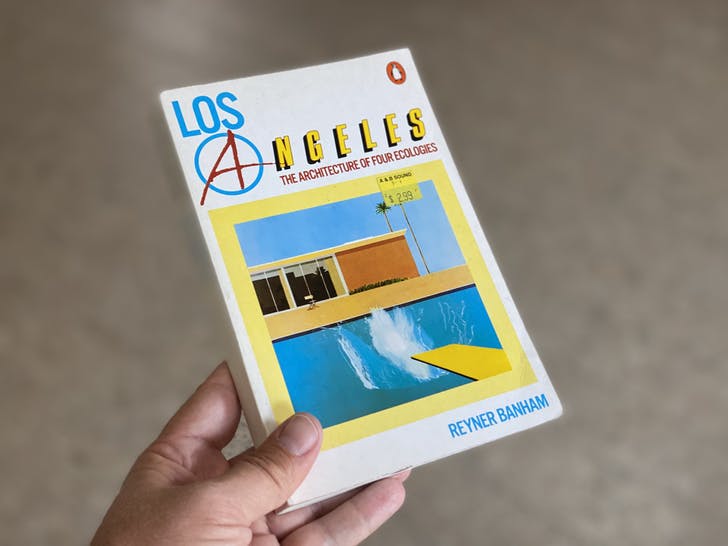
If you have an interest in Los Angeles, you also have a copy of Reyner Banham‘s Los Angeles: The Architecture of Four Ecologies. My own is a mid-1980s Pelican paperback, which I chose because it had the dumbest cover of all the editions. Though it shares with previous printings the image of David Hockney’s A Bigger Splash, an unimpeachable representation of a certain midcentury vision of the city’s hauntingly good life, its title replaces their elegant Helvetica with letterforms better suited to a post-apocalyptic action movie gone straight to video. “Angeles” is spelled out in forward-slanting, shadow-casting, bright yellow capitals but for the red initial “A,” rendered as if hastily spray-painted and set inside a circle to form the 1970s anarchy symbol. Right, Los Angeles — that’s the zone of semi-controlled urban chaos obedient to no conventional rules or order, architectural or otherwise, isn’t it?
How did Banham, who died in 1988, regard this dubious piece of graphic design? Each of his many enthusiasts and exegetes active today would speculate differently, according to which facet of his oeuvre they know best. Having first trained as an aeronautical engineer before undertaking an architectural-history education, Banham first became widely known in his native England through magazine columns in the 1950s and 60s. There he practiced criticism: sometimes of architecture, to be sure, but more often of practically everything else then found at the intersection of culture and technology. In the study Reyner Banham: Historian of the Immediate Future, Nigel Whiteley sums up the range of these public-facing writings: “Car styling; the design of radios and cameras; graphics on magazines, cigarette packs and potato chip bags; the decoration of restaurants, surfboards and ice cream vans; cult films and TV programs — all were grist for his mill.”
Half a century of technological developments and cultural-studies lectures on, these subjects will strike most of us as obviously (or at least potentially) worthy of serious consideration. That wasn’t the case for Banham’s generation, whose members came of age with a painfully keen awareness of the line dividing “high” from “low.” Born in 1922 to a not particularly well-off family in the provincial town of Norwich, Banham the self-described “scholarship boy” bristled all his life at received notions of absolute cultural hierarchy. He criticized the denigration of popular taste as “old, standardized and unquestioned, public-school-pink.” From these prevailing attitudes, as well as England’s lingering wartime austerities, an escape route appeared in the form of American commercial culture, its artifacts having been imported in unprecedented abundance in the late 1940s and early 50s as Banham was working toward his PhD at the University of London’s Courtauld Institute of Art.
Read the whole thing at Archinect.